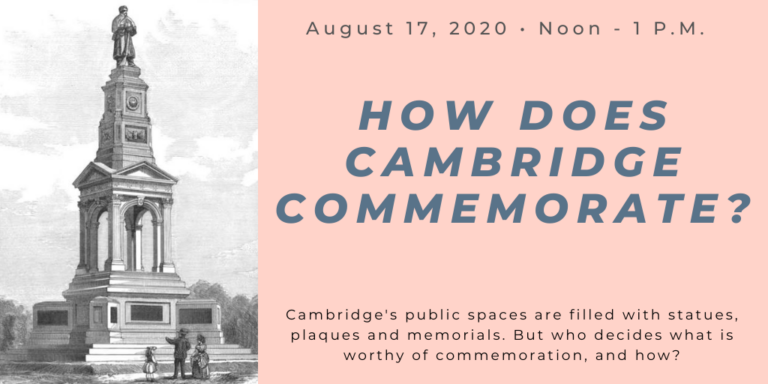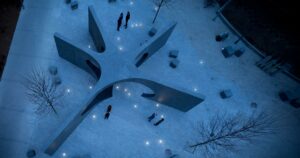
Event Recap: How Does Cambridge Commemorate?
Sun April 13, 2025
On Monday, August 17, CHS held a Virtual History Café exploring monuments and memorials in Cambridge. In this program, “How Does Cambridge Commemorate?” we examined several of the city’s most prominent public monuments, and we were joined by Kim and Sofia Bernstein, honorary members of the Cambridge Nineteenth Amendment Centennial Committee who provided the impetus for the city to create a monument to women.
We began the program with a discussion of some of the monuments most familiar to Cantabrigians, including the Charles Sumner statue in Harvard Square, the Sean Collier Memorial at MIT, and the Irish Famine Memorial on the Cambridge Common. Although we pass by these monuments often, we are largely unaware of their origin stories and how they came to be located where they are in the city. Our exploration of the Charles Sumner statue highlighted the fact that this design was the frontrunner for the statue of Sumner to be installed in the Boston Public Garden following his death in 1874. When the selection committee found out that the artist was a woman (Anne Whitney), they rejected her design in favor of one by Thomas Ball; it was not until almost thirty years later that an anonymous donor allowed Whitney to revive her design and see it installed in Harvard Square.
Other highlights of our discussion included exploring the issues of race and gender in many of Cambridge’s memorials, from the rugged white male figure in the Spanish War Memorial whose muscular physicality was meant to stand in contrast (and superiority) to their Black, Indigenous and Asian enemies, to the positioning of the slab stones of the Prince Hall Memorial, whose circular arrangement conveys both the limitations of the Black experience in early America and also its enveloping sense of community. A number of monuments date from the late nineteenth century, leading to a discussion of the Colonial Revival movement; spurred by the centennial of the Declaration of Independence in 1876, this movement ushered in a wave of nostalgia for all things early American, although these portrayals of colonial life were most often idealized rather than historically accurate.
After exploring some of the monuments already present in Cambridge, we turned our attention to one currently in the works: the Nineteenth Amendment Centennial Memorial. Sofia Bernstein and her mother, Kim, joined us to share their experience with the Centennial Committee and the drive to create a women’s memorial in Cambridge. Sofia discussed her efforts, beginning at age nine, to urge the United States Treasury Department to put a woman on the $20 bill. After progress on that work stalled, Sofia and Kim decided to concentrate their efforts locally; inspired by the petition by a Girl Scout troop in New York to add a women’s monument in Central Park, the Bernsteins decided to do the same in Cambridge. Their discussion of the multi-year process of meetings, discussions and planning illustrated the amount of preparation and coordination involved in establishing a new memorial. Kim spoke about the final four designs, noting that each of the artists’ work embodies the Committee’s vision of voting rights as an ongoing battle rather than a static victory. Sofia echoed this sentiment, discussing how the monument’s historical complexity and participatory nature dovetail with many of the issues she and other young people are passionate about, including the Black Lives Matter movement and the push for LGBTQ+ rights.
As always, our discussion left much more to be explored, most importantly the question of who are what is not memorialized in Cambridge but should be. What is missing from the city’s memorial landscape? How and where should new memorials be built? Is the Cambridge Common our “National Mall,” where all significant monuments ought to reside, or should they be spread more widely throughout the city? These are some of the important issues we will be discussing in a follow-up program – be sure to stay tuned!
If you missed the program, or if you want to watch again or share it with a friend, you can view it on our Facebook page: https://www.facebook.com/richard.hooper.1804/videos/4504054476271409






